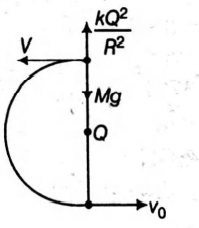Q. A particle with charge $Q$ coulomb, tied at the end of an inextensible string of length $R$ meter, revolves in a vertical plane. At the centre of the circular trajectory there is a fixed charge of magnitude $Q$ coulomb. The mass of the moving charge $M$ is such that $Mg = \frac{Q^{2}}{4\pi\varepsilon_{0}R^{2}}.$ If at the highest position of the particle, the tension of the string just vanishes, the horizontal velocity at the lowest point has to be
Solution:
